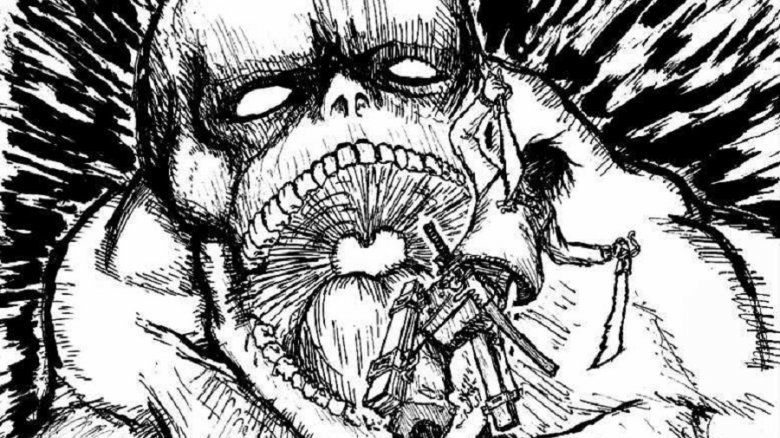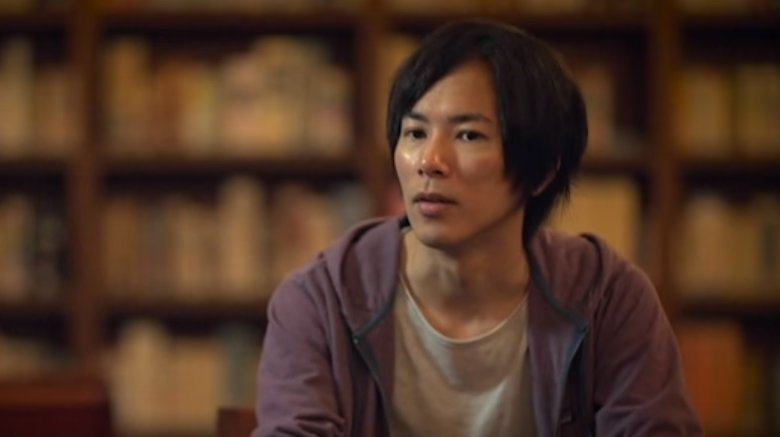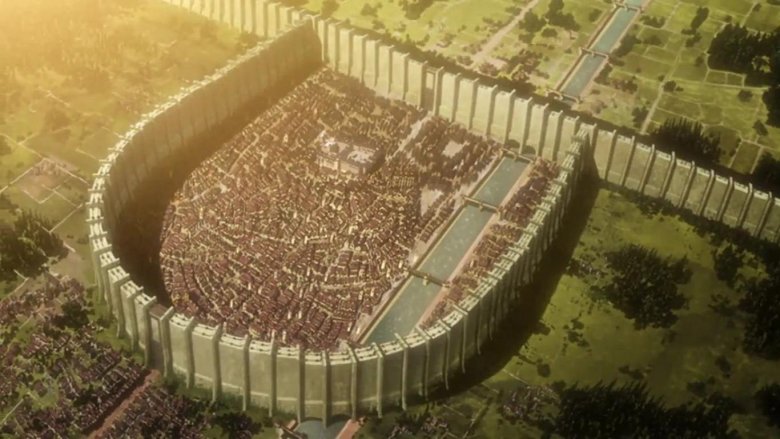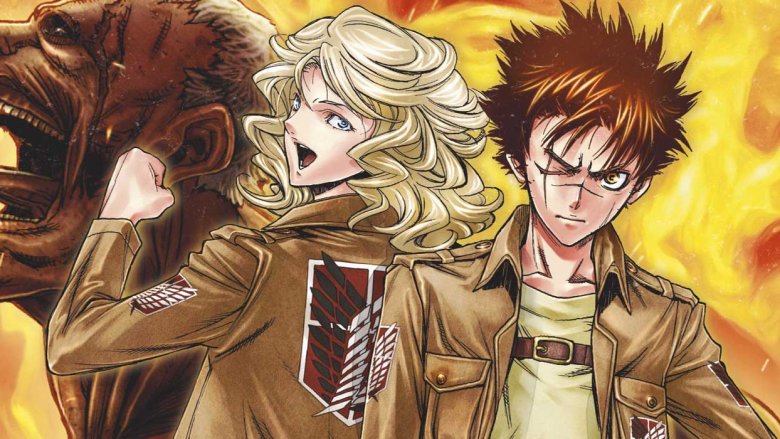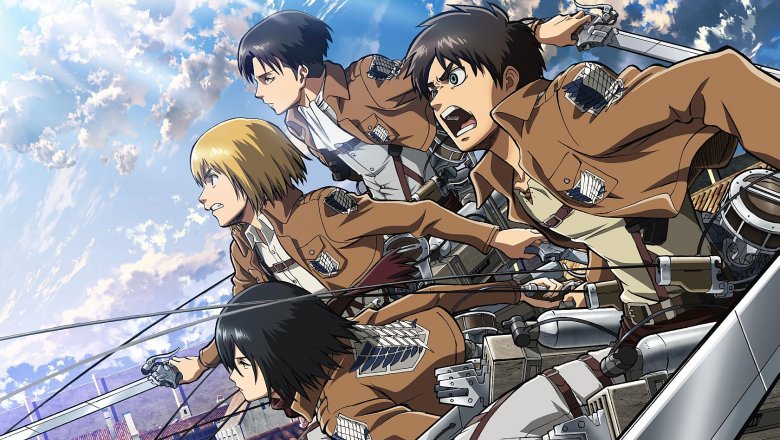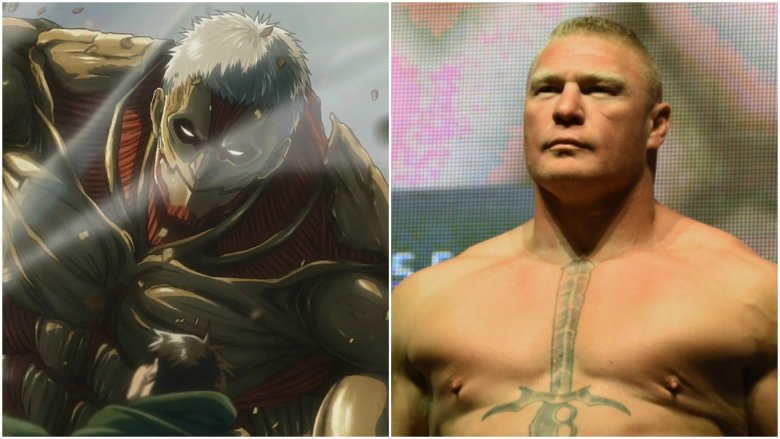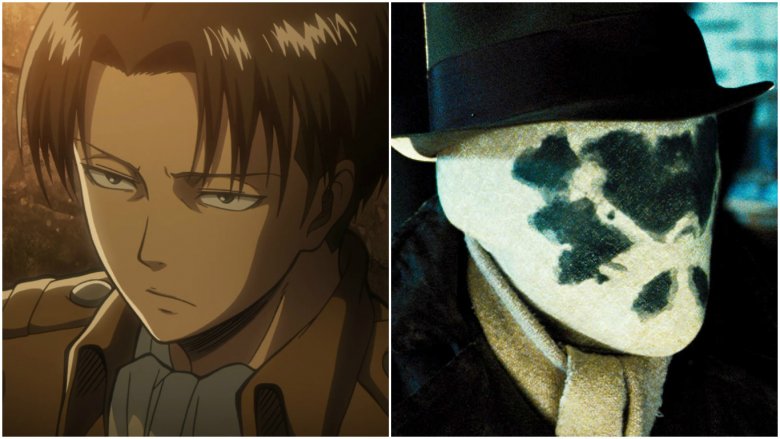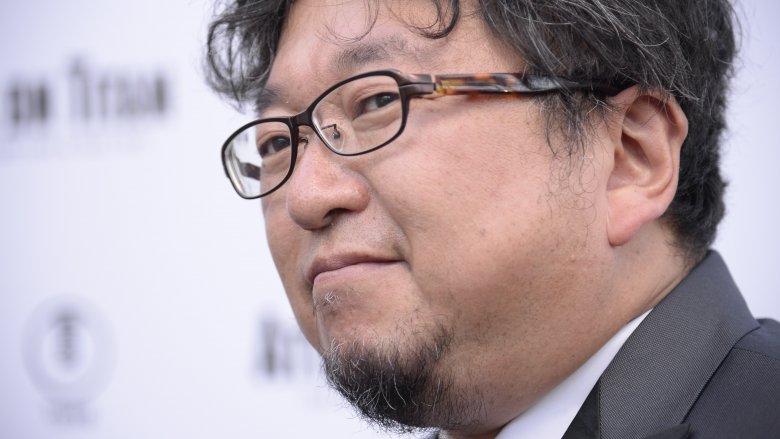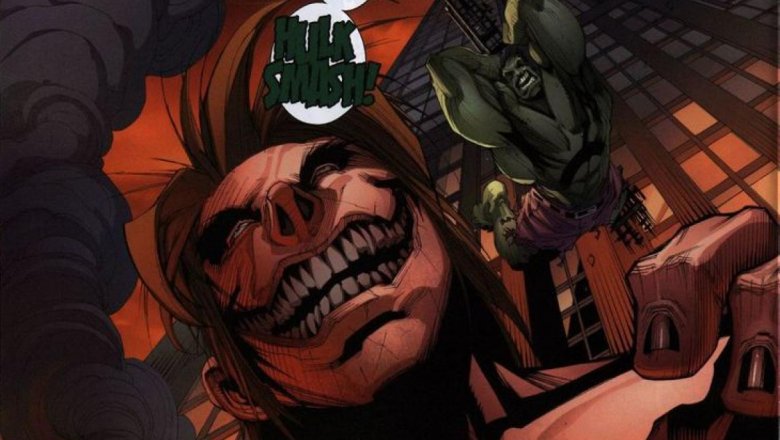The Untold Truth Of Attack On Titan
As soon as the huge walls of mankind's last stronghold are breached by vicious giants and young hero Eren witnesses his mother being eaten alive, you know there's nothing cutesy about Attack on Titan. Creator Hajime Isayama saw how the apocalyptic stories that once filled the pages of manga magazines were being slowly replaced by action comedy and slice-of-life titles, and he decided it was time to turn the clock back to a time when blood and guts ruled over song and dance.
Readers have responded enthusiastically. When it comes to manga sales alone, Attack on Titan shifted six and half million copies in 2016 to finish as the fourth most popular title in Japan overall, and it started 2017 strong, with sales second only to the ever-popular pirate series One Piece. This is the untold truth of Attack on Titan's meteoric rise.
It all started as a one-shot
Attack on Titan started as a 65-page one-shot, created by Isayama as a "prototype" when he was 19. It wasn't until a few years later that his editor came back to him with a proposal of expansion. "My editor asked me to consider making that old one-shot into a long-term series," Isayama said. "At which point I spent a half a year coming up with the details of that whole world."
Once the outline was completed and the characters created, they took Attack on Titan to Shueisha's Weekly Shōnen Jump, the top-selling manga anthology in the country. Rumor has it that Jump rejected Isayama's work because they deemed it too mature for their readership, telling him to come back with something more suitable for their audience. Instead, Isayama took Attack on Titan to Jump's rivals, Kodansha's Bessatsu Shōnen Magazine. It made its debut on September 9, 2009 and is still being published there today.
The idea came to Isayama during an altercation
Isayama came up with the premise for Attack on Titan after moving to Tokyo. As a student he was interested in physical education and combat sports, but had always been self-conscious about his slight frame, repeatedly entering sumo tournaments only to be eliminated by the bigger kids with ease. "I recognized I was inferior," he said. "I adored the strong, and I had this underlying desire to change my physique."
This desire is central to Attack on Titan's Eren Yeager, the story's dogged protagonist. When his home comes under attack from the Titans for a second time, he utilizes a special ability he didn't know he had and transforms into one of them, making the fight a little fairer. This idea came to Isayama during an incident at a late night internet cafe, where he was working to support himself in the capital. A large tourist, dissatisfied with the service he received, angrily grabbed Isayama by the collar. "I felt the fear of meeting a person I can't communicate with," he recalled, and channeled that feeling into his work.
The Walls are a reflection of Japanese culture
Isayama has said he often wonders what it would be like to live in a world without people, referencing the Will Smith film I Am Legend as a particular reference point. "I think I could actually pull it off so long as I have my living environment intact," he mused. "I could probably easily live the life of a hermit if access from the outside world were cut off." It might seem like an odd fantasy, but it's one that Japanese audiences can relate to, according to Studio WIT president George Wada, the man behind the anime adaptation.
"The idea of being isolated within the wall originated with manga creator Hajime Isayama, who was inspired by Japanese culture," Wada said at the 2013 Anime Expo in Los Angeles. "The Japanese people can become very isolated and enclosed, so it's more of a Japanese cultural idea... The 'Wall of Fear' plays a big role in the series. I think people overcoming that fear is relatable to the audience."
In the story, the last human settlement consists of three 50-meter walls (named Maria, Rose and Sina) which section the population off into classes. The wealthiest have all three walls between themselves and the Titans, while the poorer outlying camps are only a stone's throw from the bloodthirsty giants lurking outside.
Before the Fall
Isayama's editor wouldn't let the series go ahead until he had an ending in mind, so the creator definitely knows the fate of his characters, though when it comes to fleshing out a universe, he's admittedly slack. "Thinking about it now, I don't think I had thought the story all the way through back when I started it," he said in 2014. "I still feel like it's pretty shallow compared to the level of the sci-fi universes my older artist friends shared."
In order to deepen the Attack on Titan story somewhat, Kodansha brought in author Ryō Suzukaze, who penned a light novel prequel called Before the Fall. As the title suggests, this three-volume story takes place 70 years before the events of the original, in a time before mankind had fallen to the Titans. It concentrates on a boy named Kuklo (nicknamed the Titan's Son after being born inside the Titan who ate his pregnant mother) and the inception of the Vertical Manoeuvring Equipment used by the Survey Corps against the Titans.
Before the Fall, the first of three novelized spinoffs, received mixed reviews, but was given kudos for expanding on what Isayama started. "Before the Fall lives and dies by how interesting its audience finds the Attack on Titan universe," Otaku USA magazine said in their review. "If this had been a direct novelization it would have been an immediate pass, but there's something alluring about the creation of the series' key equipment."
The anime blew up
The manga was going strong when the anime first aired in 2013, and the reaction to the series only increased Attack on Titan's popularity. WIT Studio has since developed a reputation as a solid anime house, but back then, it was in its infancy—and overwhelmed by the demands of its first major project. In April of that year, with the series still ongoing, Chief Animation Director Kyoji Asano sent out a plea for help. "Is there any active animator who is interested in the Attack on Titan anime?" he tweeted. "If you are, please make contact with WIT Studio. Please lend us your strength, everyone."
Whoever they hired, they chose well, as the finished product was hailed by critics at the time and stands second only to classic psychological thriller Death Note on My Anime List. Before long, western audiences were introduced to the Titans, with Adult Swim picking up the show as part of their Toonami block. Before long, Attack on Titan was must-watch anime on both sides of the Pacific.
In the end, the show became so popular that it wound up impacting its own source material. "The anime influenced the characters in the manga," Isayama admitted. "When the characters move and come to life with actors' voices, that helps me understand the characters in more detail when I'm drawing the manga."
The Titans were based on MMA fighters
Ugly is just one word you could use to describe the Titans, and Isayama would happily agree with you. "Doodling as a kid I started drawing ugly stuff, and by the time I was in junior high it got so that I was drawing ugly things exclusively," he said. "Just as everyone's handwriting is unique to them, I think my art is idiosyncratic to me in its ugliness. People got a kick out of it and it somehow caught on."
When it came to drawing the Titan shifters (the Titan forms of those few humans able to transform), ugly just wasn't enough; they needed to be physically intimidating and terrifyingly strong. Isayama's interest in combat sports would end up heavily influencing his work here, with the creator using a number of MMA fighters as models. "There's a mixed martial artist I like named Alistair Overeem, who has this small face and developed trapezius that gives him a really intimidating physique, which is where I got the [Beast Titan] design from," he admitted.
WWE superstar Brock Lesnar was the basis for the Armored Titan, according to an interview Isayama did with Gong Kakutogi (via ComicBook.com), in which he also revealed that Eren's own Titan was inspired by the frame and fighting style of Yushin Okami, a Japanese fighter formerly of the UFC.
Levi was based on a character from Watchmen
While the world of MMA provided plenty of specimens to aid Isayama in his Titan shifter designs, when it came to creating his human characters, the artist looked for inspiration elsewhere. Levi Ackerman, captain of the special operations squad and the strongest solider humanity has to offer, didn't really begin to take shape until Isayama saw Zack Snyder's adaptation of DC's Watchmen. "Levi is a character I accidentally created while idly doodling, and I of course knew I had something," he said. "Then I saw Watchmen, and the character Rorschach really stuck with me and I decided I wanted to try doing a similar character, so I combined him with that doodle."
Despite not being the series protagonist, the ruthless Levi came out on top in a poll of people's favorite Attack on Titan characters conducted by Bessatsu Friend magazine, a result that Isayama put down to the hordes of yaoi fangirls. Yaoi (also known as BL or Boys Love) is a genre of fanfiction that involves the creation of romantic relationships between male characters. "Fans might be disappointed to hear this, but maybe I've got a little bit of yaoi fangirl inside me too, because something went off in my head that told me 'The yaoi fangirls are going to like this one.'"
Levi was left out of the live-action movies
A two-part live-action adaptation of Attack on Titan hit Japanese theaters in summer 2015 amid huge buzz, though, like so many Hollywood films these past few years, it faced scrutiny over against-race casting. While it's never been confirmed, the assumption is that Attack on Titan takes place in a fictional version of Europe, with the walled-in medieval cities of Germany a clear inspiration. Most of the main characters have Germanic names (apart from Eren's childhood friend Mikasa, who is tellingly referred to as "an oriental" in the anime), and it was because of those names that vital characters were cut from the movie.
Toho Pictures were stuck between a rock and a hard place: they wanted to make the film in Japanese, but were concerned about finding European actors who spoke the language. In the end, the decision was made to set the movie in Japan instead. What they couldn't do without risking fan backlash was make the characters' names Japanese, so they kept the original ones where they could. Unfortunately, some western names just don't make sense. In the end, only a handful of names from the manga made it to the big screen, and many characters were invented for the films, which concentrate more on the relationship between Eren and Mikasa.
The filmmakers attacked critics after bad reviews
The decision to change it up so drastically ended up coming back to haunt the filmmakers, as the reaction to the Attack on Titan movies was largely negative. "Watch Attack On Titan for the tension, the monsters and the gore, but don't expect a plot or characters even remotely as compelling as its animated counterparts," the Bangkok Post wrote in their review, and critics in the west agreed: The Hollywood Reporter called it out for a "lack of character development" and UK news outlet The Guardian criticized the "dreadful acting" on display.
Head of special effects Yoshihiro Nishimura went on the defensive, taking particular offense to those critics who complained that his effects didn't hold up to Hollywood standards. "Everyone says Hollywood movies are great," he said. "Well, then they can go right ahead and watch nothing but Hollywood movies! You should watch movies that have been hit in the face with stacks of cash! People who like to compare Hollywood and Japanese movies really enjoy that sort of thing, right?"
Director Shinji Higuchi also lashed out, publicly wondering "who's the idiot who gave this guy an early release of the film" after a critic called the plot and characters stupid and admitted to rooting for the Titans over the humans by the end.
There's a Marvel crossover called Attack On Avengers
If you needed proof that Attack on Titan is well on its way to ingraining itself in pop culture, look no further than Attack on Avengers, a special 8-page manga in which the titular giants do battle with Earth's Mightiest Heroes on the busy streets of New York City. As the most vicious Titans emerge from the ocean and begin devouring the people of Manhattan, the Avengers assemble and set about stopping the carnage, calling on the Guardians of the Galaxy for a little help.
This was Marvel's first crossover with a manga property, and they chose to take the lead with it. While Isayama provided the plot outline, the story was actually written by C.B. Cebulski, with Marvel men Gerardo Sandoval and Dono Sanchez Almara contributing linework and color. It might look as though Isayama was unfairly muscled out of the creative process here, though in truth he was probably more than happy to leave the artwork to Marvel, as he's been known to doubt his own ability while working under pressure.
Poorly drawn caricatures of Attack on Titan characters credited to Isayama have appeared online, with the poster claiming they were drawn at an autograph signing held by the manga artist. Isayama responded on his personal blog, claiming responsibility for the sketches and apologizing to fans for their quality. He blamed his nerves and a lack of confidence in himself.
What's happening next?
Attack on Titan shows no signs of slowing anytime soon. Several video games have already been released, and an Attack on Titan theme park opened at Universal Studios Japan in 2015. A number of weird and wonderful lines of merchandise also exist, with everything from character coat hangers to full-size body pillows available. Most importantly, the franchise is strong where it counts—in the anime department.
While Isayama's manga has started heading towards its climax in recent chapters, the second season of the anime has proven to be even more popular than the first, and the third is already on its way. Attack of Titan fans had to wait an agonizing four years between the maiden season and its follow-up, but that won't be the case this time around, as WIT Studio have confirmed the third season will drop in 2018.
In early 2017 Deadline announced that Warner Bros. was trying to buy the rights to make an English language live-action Attack on Titan, claiming that Fantastic Beasts producer David Heyman was set to take charge. A statement from Kodansha denied that a deal had been struck, but did confirm that negotiations for film adaptations of their properties are ongoing. Whether Warners takes the lead or another studio swoops in, it's only a matter of time before an Attack on Titan casting call goes out in Hollywood.
